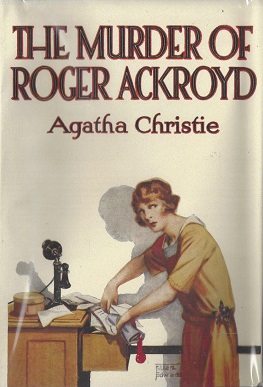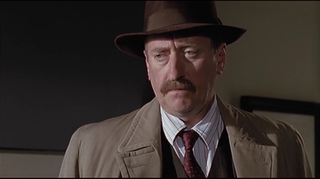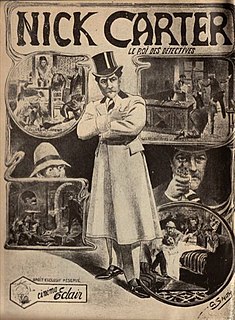Related Research Articles

Dame Agatha Mary Clarissa Christie, Lady Mallowan, was an English writer known for her 66 detective novels and 14 short story collections, particularly those revolving around fictional detectives Hercule Poirot and Miss Marple. She also wrote the world's longest-running play, The Mousetrap, which has been performed in the West End since 1952, as well as six novels under the pseudonym Mary Westmacott. In 1971, she was made a Dame (DBE) for her contributions to literature. Guinness World Records lists Christie as the best-selling fiction writer of all time, her novels having sold more than two billion copies.

Detective fiction is a subgenre of crime fiction and mystery fiction in which an investigator or a detective—either professional, amateur or retired—investigates a crime, often murder. The detective genre began around the same time as speculative fiction and other genre fiction in the mid-nineteenth century and has remained extremely popular, particularly in novels. Some of the most famous heroes of detective fiction include C. Auguste Dupin, Sherlock Holmes, and Hercule Poirot. Juvenile stories featuring The Hardy Boys, Nancy Drew, and The Boxcar Children have also remained in print for several decades.

The Mysterious Affair at Styles is a detective novel by British writer Agatha Christie. It was written in the middle of the First World War, in 1916, and first published by John Lane in the United States in October 1920 and in the United Kingdom by The Bodley Head on 21 January 1921.

The Murder of Roger Ackroyd is a work of detective fiction by British writer Agatha Christie, first published in June 1926 in the United Kingdom by William Collins, Sons and in the United States by Dodd, Mead and Company. It is the third novel to feature Hercule Poirot as the lead detective.

Captain Arthur J. M. Hastings, OBE, is a fictional character created by Agatha Christie as the companion-chronicler and best friend of the Belgian detective, Hercule Poirot. He is first introduced in Christie's 1920 novel The Mysterious Affair at Styles and appears as a character in seven other Poirot novels, including the final one Curtain: Poirot's Last Case (1975), along with a play and many short stories. He is also the narrator of several of them.

Inspector James Japp is a fictional character who appears in several of Agatha Christie's novels featuring Hercule Poirot.

A mystery film is a genre of film that revolves around the solution of a problem or a crime. It focuses on the efforts of the detective, private investigator or amateur sleuth to solve the mysterious circumstances of an issue by means of clues, investigation, and clever deduction.

The Mystery of the Blue Train is a work of detective fiction by British writer Agatha Christie, first published in the United Kingdom by William Collins & Sons on 29 March 1928 and in the United States by Dodd, Mead and Company later in the same year. The UK edition retailed at seven shillings and sixpence (7/6) and the US edition at $2.00. The book features her detective Hercule Poirot.

The Mysterious Mr Quin is a short story collection by British writer Agatha Christie, first published in the UK by William Collins & Sons on 14 April 1930 and in the US by Dodd, Mead and Company later in the same year. The UK edition retailed at seven shillings and sixpence (7/6) and the US edition at $2.00.

Ursula Jean McMinn, better known as Ursula Jeans, was an English film, stage, and television actress.

Three Blind Mice and Other Stories is a collection of short stories written by Agatha Christie, first published in the US by Dodd, Mead and Company in 1950. The first edition retailed at $2.50.

Agatha Christie's Marple is a British ITV television programme loosely based on the books and short stories by British crime novelist Agatha Christie. The title character was played by Geraldine McEwan from the first to the third series, until her retirement from the role, and by Julia McKenzie from the fourth series onwards. Unlike the counterpart TV series Agatha Christie’s Poirot, the show took many liberties with Christie’s works, most notably adding Miss Marple’s character to the adaptations of novels in which she never appeared. Following the conclusion of the sixth series, BBC acquired the rights for the production of Agatha Christie adaptations, suggesting that ITV would be unable to make a seventh series of Marple.

Problem at Pollensa Bay and Other Stories is a short story collection by Agatha Christie published in the UK only in November 1991 by HarperCollins. It was not published in the US but all the stories contained within it had previously been published in American volumes. It retailed at £13.99. It contains two stories with Hercule Poirot, two with Parker Pyne, two with Harley Quin and two gothic tales.
Leslie Stephenson Hiscott was an English film director and screenwriter who made over sixty films between 1925 and 1956. He was born in London in 1894. He directed Alibi (1931), the first ever depiction of Hercule Poirot, Agatha Christie's Belgian detective, with Austin Trevor in the lead role. He directed a follow-up, Black Coffee, also starring Trevor.

Alibi is a 1931 British mystery detective film directed by Leslie S. Hiscott and starring Austin Trevor, Franklin Dyall, and Elizabeth Allan.
S.O.S. is a 1928 British silent adventure film directed by Leslie S. Hiscott and starring Robert Loraine, Bramwell Fletcher and Ursula Jeans. The film takes its title from the morse code distress signal S.O.S. It was made at Lime Grove Studios.

Agatha Christie (1890–1976) was an English crime novelist, short-story writer and playwright. Her reputation rests on 66 detective novels and 15 short-story collections that have sold over two billion copies, an amount surpassed only by the Bible and the works of William Shakespeare. Her works contain several regular characters with whom the public became familiar, including Hercule Poirot, Miss Marple, Tommy and Tuppence Beresford, Parker Pyne and Harley Quin. Christie wrote more Poirot stories than any of the others, even though she thought the character to be "rather insufferable". Following the publication of the 1975 novel Curtain, Poirot's obituary appeared on the front page of The New York Times.

Clifford Heatherley Lamb was an English stage and film actor.
In Agatha Christie's mystery novels, several characters cross over different sagas, creating a fictional universe in which most of her stories are set. This article has one table to summarize the novels with characters who occur in other Christie novels; the table is titled Crossovers by Christie. There is brief mention of characters crossing over in adaptations of the novels. Her publications, both novels and short stories, are then listed by main detective, in order of publication. Some stories or novels authorised by the estate of Agatha Christie, using the characters she created, and written long after Agatha Christie died, are included in the lists.
The Mystery of Mr. Bernard Brown is a 1921 British silent mystery film directed by Sinclair Hill and starring Ruby Miller, Annie Esmond and Clifford Heatherley. It was made by Stoll Pictures, and based on an 1896 novel The Mystery of Mr. Bernard Brown by E. Phillips Oppenheim.